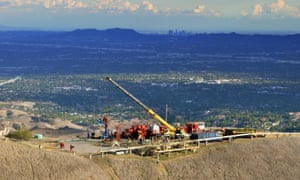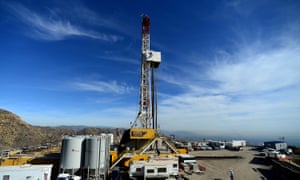A single gas well leak is California’s biggest contributor to climate change
Rupture of Aliso Canyon well has released more than 77,000 metric tons of methane and refocused attention on America’s accident-prone infrastructure
The Guardian

SoCalGas crews and technical experts try to stop the flow of natural gas leaking from a storage well at the utility’s Aliso Canyon facility. Photograph: Javier Mendoza/AP
The single biggest contributor to climate change in California is a blown-out natural gas well more than 8,700ft underground, state authorities and campaign groups said Monday.
The broken well at the Aliso Canyon natural gas storage site has released more than 77,000 metric tons of the powerful climate pollutant methane since the rupture was first detected on 23 October, according to a counter created by the Environmental Defense Fund.
Methane is a fast-acting climate pollutant – more than 80 times more powerful than carbon dioxide over a 20-year time frame.
Experts believe the breach, which has forced the evacuation of hundreds of residents from the town of Porter Ranch, is the largest ever in the US.
Locals have complained of headaches, sore throats, nosebleeds and nausea, caused by the rotten-egg smell of the odorant added to the gas to aid leak detection by SoCalGas, the utility that operates the natural gas storage site.
About 1,000 people are suing the company. There are also concerns about the leak’s effect on smog and ozone. The company said it was monitoring air quality.
The leak is unlikely to be brought under control before late February – and even that timetable depends on work crews’ success in locating and plugging a 7-inch pipe deep underground.

Campaign groups said the release undercuts Barack Obama’s efforts to slow the rate of global warming to avoid a tipping point and live up to US commitments to a historic climate accord agreed in Paris last month.
Obama is expected to tout his climate agenda during his State of the Union address on 12 January – one of his last big moments remaining to promote a key presidential priority.
Carbon dioxide is still the biggest driver of climate change. But because methane emissions are on the rise and exercise such a powerful effect in the short-term, they are a growing source of concern as governments try to avoid a climate tipping point.
A byproduct of the oil and gas industry and agriculture, methane accounts for about a quarter of the world’s warming.
The release of methane from the ruptured well has now slowed considerably since its peak in late November, according to Carb.
Back then, the climate impact was equivalent to the daily emissions from 7 million cars – or the equivalent of six coal-fired power plants, or three-quarters of the emissions from the state’s entire oil refining industry, according to EDF.
But David Clegern, a spokesman for the agency, said the well remained a major source of climate pollution. “It is in California at this point the single largest source point of global warming,” Clegern said.
He also said it was to his knowledge the biggest such natural gas leak ever. “We haven’t been able to see anything anywhere near this size.”

The Aliso Canyon leak is much less visible than BP’s oil disaster, but Mark Brownstein, who heads the climate and energy program at EDF, said it is a serious threat.
“For the planet it is a big deal because methane is a such a powerful greenhouse gas, and the huge amount of gas that is escaping,” he said.
The rupture at the Aliso Canyon facility has refocused attention on America’s ageing and accident-prone oil and gas infrastructure. Many such leaks go undetected.
The Environmental Protection Agency is due to issue much-anticipated rules to control methane emissions from the oil and gas industry later this year. Gina McCarthy, who heads the EPA, said on Monday that the rules could avoid up to 400,000 metric tons of methane by 2025.
The Aliso Canyon storage site is one of the biggest such facilities in the country, and was originally built for the oil industry about 60 years ago. When the oil fields were exhausted, the well was repurposed as a storage site.
R Rex Parris, who is suing the gas company on behalf of Porter Ranch residents, said the site should have been shut down long ago.
He faulted the company for removing a blow-out preventer at the bottom of the well in 1979. “They deliberately took the brakes off the car and continued to drive it. That’s the best metaphor I can come up with, he said. “They are saying it’s an accident that they ran into somebody. I’m saying: ‘no, it was inevitable’.”
A company spokeswoman said the well was in compliance with state regulations.
__
http://www.theguardian.com/environment/2016/jan/05/aliso-canyon-leak-california-climate-change
